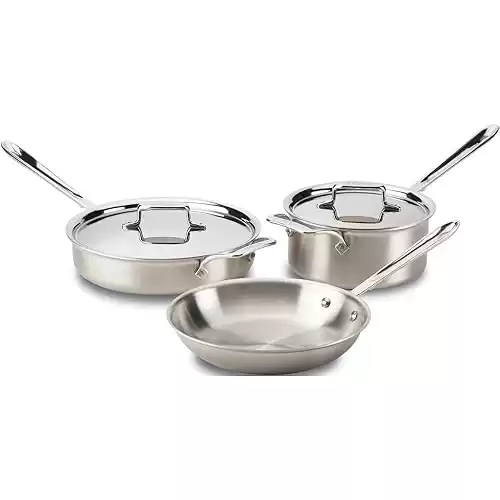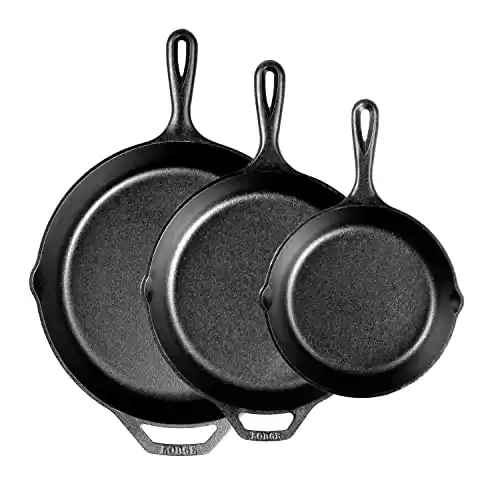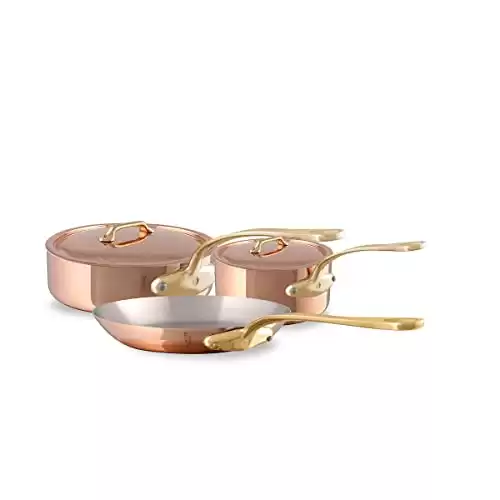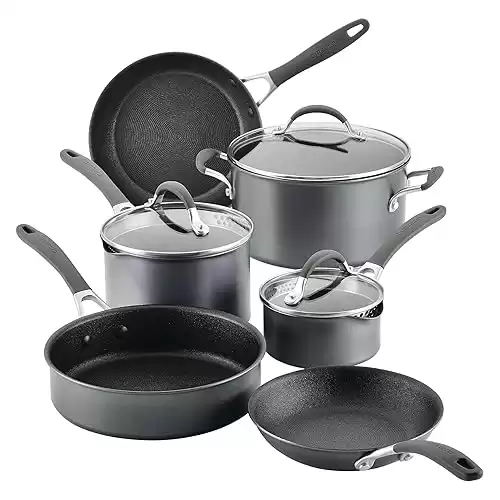
Cast iron and stainless steel are some of the most long-lasting materials for pots and pans due to their resistance to wear and ability to withstand frequent use.
These materials offer superior heat retention and distribution, making them favorites among both amateur cooks and professional chefs.
When selecting cookware, it’s essential to consider the type of cooking you’ll be doing and the maintenance each material requires.
For instance, cast iron might require seasoning to maintain its non-stick quality, while stainless steel requires a bit more care to avoid water spots and maintain its shine.
Understanding these nuances helps ensure that the pots and pans you choose remain in good condition for years to come.
Exploring the different types of cookware can reveal which are most suited to your needs and lifestyle.
Materials like copper and aluminum are excellent for heat conductivity but may not last as long without proper care.
By choosing wisely, you can enjoy cookware that offers both performance and longevity, making meal preparation enjoyable and efficient.
Pots and Pans that Last
|
Our Rating:
4.5
|
Our Rating:
4.6
|
Our Rating:
4.7
|
Our Rating:
4.5
|
|
$499.95
|
$55.40
|
$899.95
|
$279.99
|
|
Description: Renowned for its superior craftsmanship and multi-ply construction, combining stainless steel with aluminum or copper cores for exceptional heat distribution and durability. Favored by professional chefs and home cooks alike, All-Clad offers versatile, long-lasting performance across a wide range of cooking tasks. |
Description: Celebrated for its high-quality cast iron products, offering exceptional heat retention and durability at an affordable price. Known for its pre-seasoned cast iron skillets and Dutch ovens, Lodge provides versatile, long-lasting cookware suitable for stovetop, oven, and campfire cooking. |
Description: A premium brand specializing in expertly crafted copper cookware, prized for its superior heat conductivity and elegant design. With a heritage dating back to 1830, Mauviel is a top choice for professional chefs and culinary enthusiasts seeking precision and performance in their kitchen. |
Description: Known for its innovative non-stick technology and durable hard-anodized construction, offering effortless food release and excellent heat distribution. Designed for everyday convenience, Circulon pans feature unique raised circular ridges that enhance durability and reduce surface abrasion, making them a favorite for home cooks. |
Renowned for its superior craftsmanship and multi-ply construction, combining stainless steel with aluminum or copper cores for exceptional heat distribution and durability. Favored by professional chefs and home cooks alike, All-Clad offers versatile, long-lasting performance across a wide range of cooking tasks.
Celebrated for its high-quality cast iron products, offering exceptional heat retention and durability at an affordable price. Known for its pre-seasoned cast iron skillets and Dutch ovens, Lodge provides versatile, long-lasting cookware suitable for stovetop, oven, and campfire cooking.
A premium brand specializing in expertly crafted copper cookware, prized for its superior heat conductivity and elegant design. With a heritage dating back to 1830, Mauviel is a top choice for professional chefs and culinary enthusiasts seeking precision and performance in their kitchen.
Known for its innovative non-stick technology and durable hard-anodized construction, offering effortless food release and excellent heat distribution. Designed for everyday convenience, Circulon pans feature unique raised circular ridges that enhance durability and reduce surface abrasion, making them a favorite for home cooks.
Understanding Cookware Materials

Selecting the right cookware materials is crucial for durability and performance.
Leading brands offer cookware in various materials, each with distinct benefits and challenges.
Choosing among these depends on your cooking needs, maintenance preferences, and longevity expectations.
STAINLESS STEEL COOKWARE
Stainless steel cookware, like All-Clad, is praised for its resilience and longevity.
It’s resistant to rust and staining, withstanding high temperatures, making it ideal for stove-to-oven use.
Tri-ply construction, often incorporating aluminum or copper cores, enhances heat distribution.
Maintenance involves regular cleaning to maintain its shine. It’s dishwasher-safe, adding convenience.
However, it requires oil or water to prevent sticking, which might not suit all cooking styles.
CAST IRON COOKWARE
Cast iron cookware from brands like Lodge is renowned for its durability and excellent heat retention.
It stays hot for extended periods, providing consistent cooking results.
Seasoning is required to maintain its nonstick surface and prevent rust, making it a bit maintenance-intensive.
Cast iron improves with use, developing a natural patina over time.
It’s versatile, suitable for stovetop, oven, and even campfire cooking.
CARBON STEEL COOKWARE
Carbon steel cookware, offered by brands like Mauviel and Matfer Bourgeat, shares similarities with cast iron but is lighter and more responsive to heat changes.
It requires seasoning to develop a natural nonstick surface.
Ideal for searing, browning, and frying, carbon steel pans heat and cool quickly.
With proper care, it’s durable and resistant to warping.
Its lighter weight makes it more manageable than cast iron, yet requires similar maintenance.
CERAMIC COOKWARE
Ceramic cookware, such as GreenPan, offers a nonstick surface without PTFE or PFOA, making it an appealing choice for health-conscious cooks.
It’s chemically inert, meaning it doesn’t leach substances into food.
Ceramic pans are aesthetically pleasing with vibrant exteriors.
They require gentle cleaning to avoid damaging the ceramic coating.
Over time, the nonstick properties may diminish, necessitating careful use to prolong their lifespan.
NONSTICK COOKWARE
Nonstick cookware from brands like T-fal and Calphalon, often featuring PTFE (commonly known as Teflon), allows for easy food release and cleanup.
It’s ideal for low-fat cooking, requiring minimal oil or butter.
Nonstick pans should be used over moderate heat to maintain the coating.
PFOA-free options are available, addressing health concerns.
While convenient, it requires careful handling to avoid scratching and is less durable than some other materials.
COPPER COOKWARE
Copper cookware, such as those by Mauviel, is prized for its superior heat conductivity, offering precise temperature control.
It’s often lined with stainless steel to prevent copper leaching into food.
Ideal for dishes requiring exact heat management, it heats quickly and cools rapidly.
Copper requires polishing to maintain its appearance, and its higher cost and maintenance needs might not suit every budget or lifestyle.
ALUMINUM COOKWARE
Aluminum cookware from brands like Cuisinart and Circulon is affordable, lightweight, and conducts heat efficiently.
Often anodized or clad with other metals to enhance durability and reduce reactivity, it’s popular in both professional and home kitchens.
Anodized aluminum provides a non-reactive surface, preventing metallic tastes in food.
It’s typically dishwasher-safe, though hand washing is recommended to preserve the finish.
Its versatility makes it a staple for various cooking tasks.
ENAMELED CAST IRON
Enameled cast iron, from renowned brands like Le Creuset and Staub, combines the benefits of cast iron with a protective enamel coating to prevent rust and eliminate the need for seasoning.
It’s visually appealing, with colorful exteriors and non-reactive interiors.
Suitable for acidic foods like tomato sauce, it offers versatility from stovetop to oven.
While heavy, it’s relatively easy to maintain and resistant to rusting, offering long-lasting performance with proper care.
Factors Contributing to Longevity

The lifespan of pots and pans hinges on various factors.
Key elements include temperature tolerance, the choice of utensils, and the construction quality of the cookware.
Influence of Temperature
High temperatures can be a major factor in determining how long cookware lasts.
Some materials, like cast iron and stainless steel, are particularly adept at withstanding such heat without degrading.
Anodized aluminum is another material known for its resilience to high temperatures, making it a popular choice for long-lasting cookware.
Frequent exposure to extreme heat, however, can lead to warping or gradual wear, even in durable materials.
Proper management of heat levels during cooking can extend the life of pots and pans significantly.
For example, keeping temperatures within the recommended range for each material minimizes damage.
Impact of Utensil Choice
The utensils used during cooking can greatly affect the longevity of cookware.
Metal utensils can scratch non-stick surfaces, reducing their effectiveness and lifespan.
In contrast, using utensils made from silicone, wood, or plastic can help preserve these surfaces.
Regular use of metal on aluminum core or anodized aluminum cookware might also result in scratches or damage if not used carefully.
Therefore, choosing the right utensils is crucial in maintaining the integrity and durability of cookware.
A simple switch in utensil material can lead to cleaner, longer-lasting pans.
Importance of Cookware Construction
Construction plays a pivotal role in how well a piece of cookware endures over time.
Pots and pans with a robust build, such as those featuring an aluminum core, distribute heat more evenly and resist warping.
The multi-layered design, often seen in high-end pans, offers both durability and efficient cooking.
Quality craftsmanship in joint sections, like handles and lids, determines the overall toughness.
Choosing cookware with a balance of materials—such as copper and stainless steel or anodized aluminum—ensures not only longevity but also optimal performance.
The manufacturing process and material blend used can spell the difference between years of use and premature replacement.
Care and Maintenance Tips

Effective care and maintenance of pots and pans extend their lifespan, ensuring reliable performance over time.
Key practices include consistent cleaning, proper storage, mindful use of cooking surfaces, and careful selection of cooking sprays and coatings.
Cleaning and Seasoning
Regular cleaning is essential to maintain the performance and longevity of pots and pans.
For stainless steel and cast iron, hand-washing with a mild detergent is recommended.
Avoid using harsh abrasives that may damage the surface.
Seasoning cast iron prevents rust and maintains a natural nonstick layer.
Applying a thin layer of oil after cleaning and heating it in the oven enhances its nonstick properties.
Ceramic cookware should be cleaned with a soft sponge to preserve its surface.
Proper Storage
Storing cookware properly prevents unnecessary wear and damage.
It is advisable to hang pots and pans to avoid stacking.
For those who must stack, placing a protective layer like a soft cloth or paper towel between each item reduces the risk of scratches, especially in nonstick and ceramic cookware.
Keeping lids unclipped from pots and pans reduces moisture buildup and potential odor retention.
Usable Cooking Surfaces
Each cookware material works best on particular cooking surfaces.
Induction cooktops may require stainless steel or cast iron, while gas and electric stoves are generally suitable for most materials.
It is important to check compatibility with your cookware.
Nonstick and ceramic pans should be used at medium to low temperatures to protect their coating.
This practice prolongs their life and prevents surface damage that might occur under high heat.
Cooking Sprays and Coatings
Using cooking sprays can degrade the nonstick surface over time as their additives may cause buildup.
Instead, applying a small amount of oil or butter maintains the nonstick effectiveness without damaging the surface.
For ceramic and nonstick pots and pans, avoiding metal utensils prevents scratching.
Silicone or wooden utensils are ideal for use, preserving the coating and extending the lifespan of the cookware.
Best Practices for Use

When using pots and pans for longevity, attention to proper use on different cooktops and ovens can help extend their life.
Efficient use involves understanding compatibility and handling instructions for each cooking surface.
Cooking on Induction Cooktops
Induction cooktops require specific cookware with magnetic bases.
Stainless steel and cast iron are excellent choices due to their magnetic properties.
When using these, ensure that the cookware’s bottom is flat and smooth for even heat distribution.
To prevent damage, avoid dragging pots across the cooktop surface.
This will help reduce scratches.
It’s also important to begin with low heat settings to prevent sudden temperature changes.
Regularly clean both the cooktop and the cookware to maintain performance and appearance.
Important Tip: For those using sheet pans, ensure they are induction compatible. This minimizes any risks of inefficient cooking or surface damage.
Utilizing Various Types of Ovens
When using ovens, ensure that cookware can withstand high temperatures.
Cast iron and enameled steel are typically safe for standard and convection ovens.
They distribute heat evenly, reducing hot spots and ensuring thorough cooking.
For air fryers, consider smaller pans that fit comfortably inside.
Non-stick pans can be particularly useful here, as they simplify the cleaning process.
Always check for oven-safe symbols on cookware to ensure compatibility.
Avoid sudden temperature changes, such as moving hot pans into cold water.
This can warp or crack them. Regular inspection after use helps in maintaining their condition.
Premium Sets for Enthusiasts
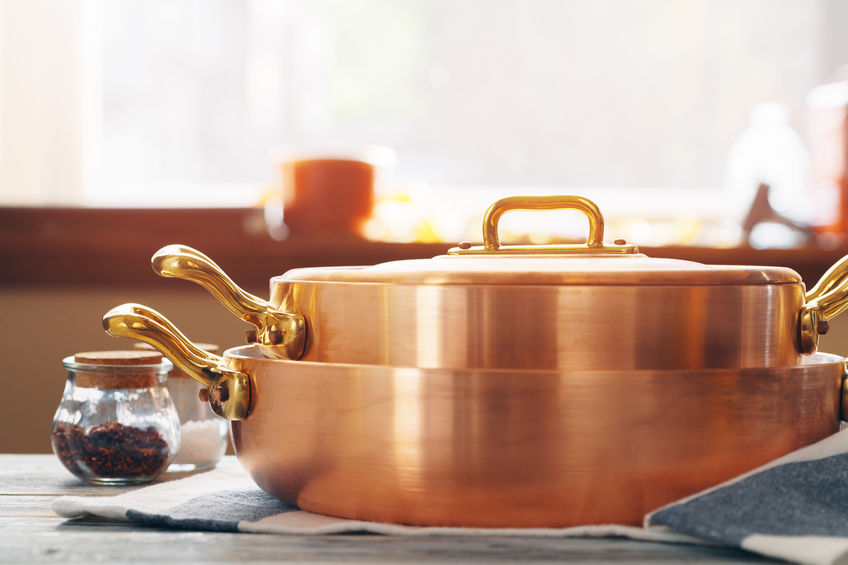
Enthusiasts may appreciate the precision and aesthetics of Mauviel copper cookware sets, known for superior heat conductivity and control.
These sets often include various pots and pans designed for specific tasks, enhancing cooking performance.
While requiring more care to maintain their appearance, copper sets often become a centerpiece in the kitchen due to their distinctive look.
For those preferring less maintenance, GreenLife pure ceramic cookware provides a non-toxic, eco-friendly alternative, staying true to its rich color despite frequent use.
Ceramic is safe for all stove types and retains heat well.
Such features make it highly appealing for dedicated cooks seeking functionality without compromising on style.
Concluding Thoughts

Choosing durable pots and pans involves considering materials, construction, and maintenance.
Stainless steel and cast iron are known for their longevity.
Stainless steel resists corrosion and offers a sleek look, while cast iron improves with age, making it a favorite for many seasoned cooks.
Copper provides excellent heat conduction but requires regular polishing to maintain its shine.
Non-stick cookware, often coated with Teflon or ceramic, offers convenience but may need replacement if the coating deteriorates.
Investing in quality cookware can reduce the frequency of replacements.
High-quality multi-ply stainless steel, which layers different metals, combines durability with good heat distribution.
Tips for Longevity
- Regular Maintenance: Cleaning according to manufacturer instructions preserves coatings and materials.
- Storage Considerations: Proper storage prevents scratches and other damage.
- Usage Habits: Using appropriate utensils, like wood or silicone, extends the life of non-stick surfaces.
Understanding these factors helps in making informed decisions that impact the longevity of kitchen tools.
Quality materials and proper care ensure many years of reliable performance from pots and pans.


